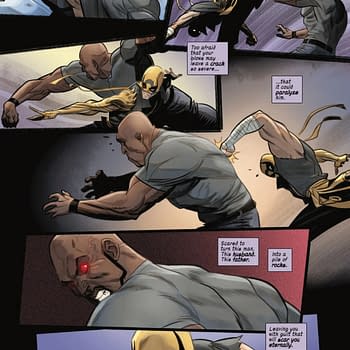Posted in: Comics, Recent Updates | Tagged: Allan Amato, art, Bill Sienkiewicz, Comics, daredevil, dave mckean, David Mack, dexter, documentary film, elektra, entertainment, grant morrison, Greg Ruth, illustration, joe quesada, Marvel Comics, Photography, showtime, The Temple of Art
Breaking Down Clichés And Truth-Telling The Creative Life In The Temple Of Art – David Mack And Bill Sienkiewicz In The Bleeding Cool Double-Interview
The Temple of Art is a documentary project and book project, currently crowdfunding, the brainchild of photographer Allan Amato that arose out of his photographic portraits of artists in a variety of multi-modal mediums. It has grown to encompass some of the most visionary creators in their respective fields and to make a statement about the nature of the creative life, its difficulties and triumphs, but above all to break down the encrusted cliches through which society might otherwise continue to view art and the people who make art.
I'm fairly deeply indebted to one of my reporters, Joshua Stone, who pulled me aside from the chaotic happenings of San Diego Comic Con to tell me that I must attend The Temple of Art panel at the con, that I would be glad I did. He was right. Through an introductory video and a massive slate of panelists talking about their work and the project, I got a taste of what The Temple of Art is all about, and if there's one phrase that most defines the project, in my opinion, it's the human factor.
We need criticism of art in our culture, and we need discussion on a high analytical level, but all that loses much of its meaningfulness if we don't hear from artists in their own vital words about what their lives are like, what motivates them, and to what degree they feel "connected" to other creators. The Temple of Art is a project that captures these invaluable elements, and cannot help but relentlessly surprise you with what artists have to say, and show, to represent their experiences.
Two participants in the project, David Mack and Bill Sienkiewicz, spoke to us here at Bleeding Cool about their lives, their work, and their involvement in The Temple of Art.

Hannah Means-Shannon: David, has becoming involved in this project challenged the way you view yourself as an artist and your own process? Making art can no doubt be all-consuming and stopping to look at yourself from the outside, and trying to shape how people view you and your work might be a secondary, new approach…

David Mack: It is interesting to be the subject of a photographer who is a real artist. Especially an artist that has such a strong point of view and powerful personal style, especially when you respect their work and their choices and shape of reality. It is interesting to see yourself through their lens.
I've been the subject of other photographers that I respect who have very strong personal styles and points of view, such as Linda Costa, Gemma Flemming, Sybilka Storey. Mostly women photographers now that I think on it, and I've always been fascinated with their takes on reality.
I think its interesting when someone captures a version of you that is you physically… but that also includes something about your internally that they are able to see and then present. Perhaps it is that a great photographer can abstract something that makes something even more real.
In the case of Allan Amato, I respected his work, and connected with him as an artist, so that when he asked me to paint on top of his portrait of me… I think that I saw it as a work of his, and I did not want to desecrate his work. So I tried to tinker with it in a way that added something unique to my own art approach but that also still showcased his work.
HMS: Has documenting your processes step by step made you appreciate more fully the decisions you make on a daily basis or recognize what's unique or shared about your working methods?
DM: Last week Allan filmed a discussion between myself, Bill Sienkiewicz and Stephanie Inagaki.
We are all having an art exhibit together at Century Guild in Los Angeles on Sept 20th. Allan asked us questions about our thoughts on making things, and that is always fascinating to have to articulate into words. That is especially rewarding to do with Bill. He and I have had several panel discussions and public talks/presentations in multiple cities about our approach and ideas behind making things, and it is helpful to have to articulate that into words in a way that is hopefully clear to other people. I think it helps us crystallize the process in our own minds in a way that may illuminate something for ourselves.
HMS: Has being involved in Temple of Art opened up more avenues of discussion with other artists or made you feel solidarity for your lifestyle and commitment?
DM: I go through a rhythm each day, in which I like to have quite and thoughtful alone time making things, but then also a time when I like to bounce my ideas off of someone else to get their objective opinions of if I'm communicating clearly with my ideas. And I also very much enjoy making things in the same room as other people creating their works as well.
Some people know that I sometimes spend weeks at Brian Bendis' house, writing in the same room that he is writing. Or when I was writing Daredevil: End of Days, I was staying at actor Thomas Jane's home while he was creating music for his album. When what turned out to be The Temple of Art project began… and I guess by that, what I mean is when Allan first told me that he wanted to photograph me… after he photographed me, I ended up staying at his studio loft for the next couple weeks when I was working on Showtimes' Dexter. I'd often end up drawing the subjects that Allan would also photograph. It is incredible to be making things in the space of another artist making things.
Bill and I were talking at the signing at Meltdown last week, that we had created quite a wonderful community of artists around us during the genesis of this project and now.

HMS: Did the fact that you use painting and collage make you more of a natural fit for the project because of it's multi-modal approach to artistic projects?
DM: Could be. I ended up painting and collaging right on top of the portraits. Most of my fine art work and exhibits in the last couple years has been quick brush and ink drawings of figures from life (two gallery shows of my work with Egon Schiele and Gustav Klimt, and one with Clive Barker and Dave McKean at Century Guild). But for collaborating on Allan's portraits, paint and collage seemed to be the way to go.
HMS: To what degree do you feel that all artwork is a form of storytelling and why do you chose the materials you use to tell your stories in comic art?
DM: I'm primarily a writer, really, so for books, I start with the story first, and that gives me a great liberty to consider what would be the best visual approach for that particular story or scene. So I try to ask what is the best medium, or colors or rhythm, or layout, or what visual style should I cultivate or invent for that particular story sequence in service of that story. That gives me a limber approach to the visuals because it is all in support of my story as the writer.
As far as artwork being a form of storytelling… I think it is perhaps a form of language and communication. My introduction to making things was as a child, I observed my mother as a first grade teacher, making things visual to teach her students their colors or words, or seasons, or numbers. She would come up with clever visual ways to communicate to the students so I think I began using her materials to make things as a means of communication.

HMS: For you, what are the best aspects of an artistic life, and what are the worst?
DM: Well the least best parts are the deadlines. I love making things, and I can make them quickly, but if it's a story, I like to finesse it until it is just right. And an arbitrary date for that can be useful but can also me maddening if you have lots of deadlines at the same time.
The best parts… well you get to write stories, and make things, and turn your ideas into reality each day. I look at it as a laboratory for experimenting. It helps to keep a whimsical, playful approach. So I try all kinds of ideas for a project from the silly to the sublime. I try to keep my mind in a state of silly, especially if I am doing some thing serious. The more interesting ideas can come to you in that state.
And if something doesn't work, that's just part of the research and development. You learn to grow and evolve and apply that to the next thing. I think being a writer and artist, is kind of like being reincarnated in each new project. You get to create characters with different world views, and images with a different personality, and you learn empathy for others from each of those projects, and you kind of travel the wheel of life in a single lifetime by creating so many characters, stories, and points of view in each work.
HMS: Have you ever been tempted to give up art as a profession given the economic and personal stress it entails?
DM: There were a couple times in my very early comic book career where I felt disconcerted with the business situation of some publishers that I was dealing with. It is difficult as a very young person putting yourself through college and simultaneously working all day every day on your work, and then if the publisher has excuses about paying you, that can be frustrating as a very young person.
I wondered if perhaps that publishing situation was maybe not the medium for me to be in, as I kept being disappointed by the actions of a publisher in terms of paying my royalties increasingly late, production values that were not what I had thought we agreed upon, etc.
It didn't make me think that I would not work creatively, but it did make me wonder if I should move into a different avenue of creative work.
But you learn to not work with publishers or people that don't come through on that level, and then find the publishers that deliver what you need for your work at that time.
The medium was a joy, it wasn't the medium. It was that specific business situation. I soon found a publisher that I was on the same page with in terms of their ability to deliver the production values, professionalism, and business matters, and then things blossomed.
As a creative person, you have to learn how to make the work you want to make… and then how to deliver it in the right way. And how to work with the people and delivery systems that work for you. It can be a challenging system to navigate, especially when you are beginning.
Sometimes you partner with a publisher or situation and you are on the same page. But there may come a time when your work outgrows that situation, or where the priorities of that publisher and the priorities of your work take a fork in the road. That happens when you are growing with your work, and that happens as just a matter of reality as things change and evolve, and situations change. And you may have to make some difficult choices in following the right path for your work.

HMS: What high point projects have kept you going and kept you invested in new creations?
DM: I love creating my own stories. This year is the 20th anniversary of Kabuki. I made the first volume of Kabuki as my senior thesis in Literature in college, and I kept doing it.
But I also LOVE collaborating with other creators that I respect. I loved writing Daredevil: End of Days with Brian Bendis, and seeing artists Bill Sienkiewicz and Klaus Janson bring it to life. My Kabuki books got me the offer to write for Marvel and I began at Marvel as the writer of Daredevil and it was amazing to see Joe Quesada bring the stories to life.
I've loved working with Bill Sienkiewicz on our Dexter: Early Cuts for Showtime.
Assistant Directing that Dead Can Dance music video with Allan Amato was wonderful. Collaborating with Neil Gaiman on the Words of Fire poem and print and The Gold Fish Pool art.
It was wonderful to adapt Philip K. Dick's Electric Ant at Marvel.
The gallery exhibits with Gustav Klimt and Egon Schiele were a highlight.
This year I created the art and design concept for the film Captain America: The Winter Soldier with Sarofsky designs, who I met in Barcelona when we were both speakers at OFFFest.

HMS: Bill, do you think you've had an influence on visual art and the direction of comic art? What sort of stamp do you think you've left on readers' imaginations so far?
Bill Sienkiewicz: The short answer is Yes.
The longer answer is Yes, AND it's especially gratifying when I stop to think of what comics were like when I began my professional career. At that time, there was zero editorial or corporate interest–or even artistic interest–in pushing the envelope of creativity or the boundaries of what was possible with the storytelling medium.
I had fallen in love with comics as a child, fiercely so, and had drawn my own stories all through childhood, well into my teens. To me comics were– and remain– as important and viable an art form as film, literature, music or theatre. Comics were seen by many as insipid juvenile fare. That's since changed, but it has been a long hard slog to garner any respect at all. One look at the list of creators in this doc who do comics or illustration or work of a narrative nature- pretty much shows how far it's come.
Art school broadened my horizons and interests to include jazz, blues, fine art, illustration, abstract expressionism, collage; pretty much everything.
So I more or less came to comics through the front gate, but riding a very big, wheeled hollow horse, a horse that was stuffed with all my growing interests, desires and influences. Up until the New Mutants, Elektra: Assassin and Daredevil: Love and War, there was no such thing as painted artwork in comics, there was no such thing as a 'painted page rate'. Certainly there was no collage, no circuit boards, no forays into abstract expressionism, no sculpture or mixed media.
So after a few years of being labeled a clone of Neal's, I felt I had reached the point of no return. So the influences and artistic and storytelling approaches and styles that I'd been dying to employ became something I felt obsessively compelled to try come hell or high water. I was either going to succeed or fail on my own terms, or get out of the field altogether. To my great relief, and joy–and to some no small degree, a feeling of vindication–these approaches and ideas that seemed so obvious to me, seemed to touch a chord in others. Fellow professionals and readers alike.
So please pardon my above digression into providing a not quite brief historical context,
That's a long way of saying I'm honored beyond words to have influenced–even minimally– talents like Dave McKean, David Mack, Simon Bisley, Ashley Wood and others–and to call them my friends and colleagues. To see them each taking portions what I'd done and running with them, while also bringing to every piece their own brilliant perspectives, spheres of influence and life experiences–that in turn excited and interested me, is so amazing. There's nothing like your peers for a reality check. They are also tilting at the windmills du jour right alongside you. They in turn are inspiring whole new generation of creators. Which is exactly as it should be.
As far as a stamp, I'd hope it's one that is one of liberation, fun and exploration. Barring that, I'd hope for one that upsets the hell out of them. Any extreme response is fine, as long as the response is a passionate and honest one. So I want to see work by those with a specific voice and p.o.v. So follow your muse, your instincts and your gut. I get a thrill when I see someone "going for it" full tilt.

HMS: What is the initial goal that you keep in mind when creating a new image? Is it to engage intense emotions, fix something in the memory, and suggest a story? Or is it more of a personal goal?
BS: It depends on what the image is being created for. There's a list of Questions & Answers that is probably best to employ at some point in the initial approach. At the same time, I've personally found the work itself will 'let me know' how it wants to be done. A piece will suggest color or lack thereof–or will demand a certain color scheme or tonal range. Is it bold an aggressive or soft and fluid? Is it to advertise, sell something, editorialize, make a statement, ask a question or challenge preconceptions, and evoke a certain feeling? Or a combo of these things? Being able to approach paintings or illustrations or stories with a wider variety of techniques or styles–and employing them judiciously–is to employ a greater vocabulary, a wider range of expression and nuance that can touch the people you specifically want to reach and do so in varied– and hopefully more successful ways.
HMS: What's the most difficult project you've ever engaged in, personally, and what enabled you to see it through to completion?
BS: Stray Toasters–my four issue, 200-page science fiction psychological horror show. All of it is wholly mine. Everything that ultimately stands or falls on their own merit(s). There are plenty of people to thank, like the editor, and no one else to blame–no one to hide behind. A project that was simultaneously exhilarating and petrifying–feeling completely free to create as I saw fit, to stand or fall entirely on m own. Untethered from the rest of humanity–alone in my creative space–driven to the point of exhaustion and beyond. A truly amazing experience. And for me, the definition of the phrase 'feeling totally alive'.
HMS: Do you think artists are in some sense determined beyond reasonableness to keep working? What do you think pushes artists to continue to innovate despite the vicissitudes of public reception?
BS: Absolutely. I'd call us driven and even obsessed. Crazy also comes to mind.
I believe there's a need to be seen–truly seen–and thus known–and accepted–through their most personal and private means of their art. We're providing glimpses into our very center of our being, the good, the bad, and the ugly. We risk being judged, and we fear being found wanting. We fear the obliteration of a negative response, as much as we may also want and fear accolades and acceptance. Yet we court it all, and even beg for it. We also know that love or hate is preferable to the most dreaded (non) response of all: apathy.

HMS: How has working on The Temple of Art altered the way you view yourself or art itself?
BS: As infinitely more playful and forgiving than I occasionally view it. And, in keeping with the theme and intent of The Temple of Art–I'm hoping others will see something in these answers that helps them–as obtuse and verbose as they may be–but mainly to understand that failures (and successes) do not kill you. We learn and relearn that. Failure is part of the deal as much as success is–all in all, it's a very Nietzschean paradigm. Learn from your failures and from your successes–develop self-awareness and empathy. Get stronger and then go out and do it.
I'd say it's helped to reinforce the positive aspects of the process and "not sweat the small stuff"–which is of course easier said than done.
HMS: Is this project a way to bring home the credit for what actually goes into a created work in a world where people may be touched by it, but quickly move on to new experiences in the short attention span prompted by the constant stream of media?
BS: At the very least, I would hope that it does give people who are moved by art and intrigued the act of creation, a certain sense of perspective, understanding and even a kind of demystification of the process. Because as much as creators have acknowledged a level of a ineffable, intangible magic (for lack of a better term) to it all, we all know, at the end of the day, that perspiration will triumph over inspiration in 95% of the cases. Keeping your ass in the chair, or standing at an easel, putting in the hours, increases the odds of something good coming from it.

HMS: What do you hope The Temple of Art accomplishes in the mind of viewers?
BS: That viewers will find some bit of knowledge, some wayward bit of commentary, a tiny flick of a wrist on paper or canvas, helpful in their own lives and on their own journey. I'm hoping that the experience will unlock a door to seeing and understanding that up until the moment of seeing the documentary, had been closed to them for some reason.
That–and also a huge hope that those people who have zero interest in or no knowledge or care about the creative process—will gain a small level of insight and understanding— and dare I say, respect—for creative people.
I've met quite a few of these kinds of people, and it's certain that they've held artists in contempt–or beneath it–and have absolutely ironically painted many artists with a tar brush as a bunch of emotionally stunted, debauched and ignorant children. Children who suck at business, generally idiots with money, hate deadlines, and live in some pie-in-the-sky castle of rainbows and unicorns (i.e., not the "real world").
I hope that these people will come to understand that Art–in all its forms and contexts–serves a far greater purpose than they could ever imagine.
It's not a silly parasitic luxury. It's a necessity.
The world needs Art. And artists.
HMS: Can you tell us an experience of working on the project that stands out in your mind as something you'll hold onto and draw inspiration from in the future?
BS: Personally, it's the sense of community, the connection to other artists and to the viewers and readers and fans. It's feeling connected–plugged in–to oneself and to each other and to the bigger word out there–where creating in a kind of isolation is more often the norm.
The experience has been wonderful. I love and respect all the people in the documentary. They're family.
Here's the trailer video for The Temple of Art, funding through August 20th:
Hannah Means-Shannon is EIC at Bleeding Cool and @hannahmenzies on Twitter

















